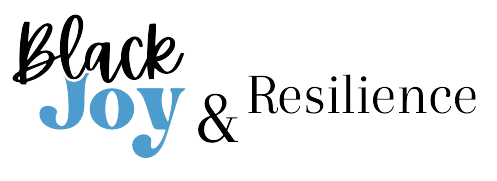Items
Tag
Play
-
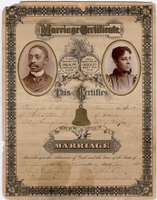 Marriage certificate, [Washington C. Young to Amanda L. West] This marriage certificate for Washington Craig Young (January 2, 1860-November 2, 1931) and Amanda L. (West) Young (June 20, 1860-January 20, 1943) features two bust-length, carte-de-visite studio portrait photographs, gold touches, pictorial details, an ornate border, and text.
Marriage certificate, [Washington C. Young to Amanda L. West] This marriage certificate for Washington Craig Young (January 2, 1860-November 2, 1931) and Amanda L. (West) Young (June 20, 1860-January 20, 1943) features two bust-length, carte-de-visite studio portrait photographs, gold touches, pictorial details, an ornate border, and text. -
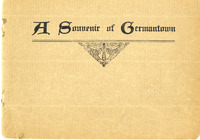 A Souvenir of Germantown Issued during the 50th Anniversary Celebration of the Emancipation Proclamation At Philadelphia, Pa., September, 1913 The Souvenir is rare and a historically significant photo booklet created and produced by J. Gordon Baugh Jr., a Black printer and civic leader based in Germantown, Philadelphia, PA. It was published in 1913 to coincide with
A Souvenir of Germantown Issued during the 50th Anniversary Celebration of the Emancipation Proclamation At Philadelphia, Pa., September, 1913 The Souvenir is rare and a historically significant photo booklet created and produced by J. Gordon Baugh Jr., a Black printer and civic leader based in Germantown, Philadelphia, PA. It was published in 1913 to coincide with -
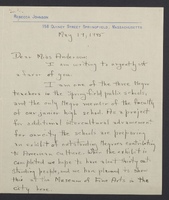 Letter, Rebecca Johnson to Miss Anderson, May 19, 1945 This letter was sent by Miss Rebecca Mary Johnson (July 10, 1905-October 4, 1991) to Miss Marian Anderson (February 27, 1897-April 8, 1993) on May 19, 1945. This letter was sent to share details about “a project for… intercultural advancement” that will feature famous Black Americans, like Marian Anderson (p. 1). Johnson asks Anderson questions about herself to be used in the exhibit for the benefit of the Springfield, Massachusetts community and youth.
Letter, Rebecca Johnson to Miss Anderson, May 19, 1945 This letter was sent by Miss Rebecca Mary Johnson (July 10, 1905-October 4, 1991) to Miss Marian Anderson (February 27, 1897-April 8, 1993) on May 19, 1945. This letter was sent to share details about “a project for… intercultural advancement” that will feature famous Black Americans, like Marian Anderson (p. 1). Johnson asks Anderson questions about herself to be used in the exhibit for the benefit of the Springfield, Massachusetts community and youth. -
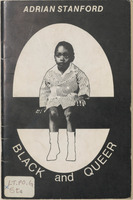 Adrian Stanford Black and Queer Adrian Stanford (d: 1981) - No online obituary or birth certificate about the poet exists. Internet records suggest that his writings were most prolific in the 1960s and 1970s (Julenetrippweaver, n.d.).
Adrian Stanford Black and Queer Adrian Stanford (d: 1981) - No online obituary or birth certificate about the poet exists. Internet records suggest that his writings were most prolific in the 1960s and 1970s (Julenetrippweaver, n.d.). -
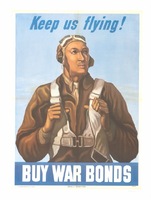 Keep Us Flying poster Poster created by the U.S. Treasury Department during World War II to encourage war bond purchase.
Keep Us Flying poster Poster created by the U.S. Treasury Department during World War II to encourage war bond purchase. -
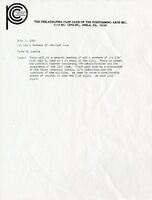 Correspondence for Bill Leslie Bill Leslie’s urgent letter to members provided a small glimpse into the Clef Club’s money matters. To dig deeper into its financial history, one would have to search the archives at the Historical Society of Pennsylvania (Philadelphia Clef Club of Jazz and Performing Arts 2013).
Correspondence for Bill Leslie Bill Leslie’s urgent letter to members provided a small glimpse into the Clef Club’s money matters. To dig deeper into its financial history, one would have to search the archives at the Historical Society of Pennsylvania (Philadelphia Clef Club of Jazz and Performing Arts 2013). -
 Letter, Ronia Barmas to the greatest singer, April 17, 1951 This letter was sent by Ronia Barnas presumably of Brooklyn, New York to Marian Anderson (February 27, 1897-April 8, 1993) on April 17th, 1951. The letter was written to complement Anderson on the remarkable beauty of her voice that reaches “never before reached heights” (p. 2). Signing the letter off as Anderson’s “admirer,” Barnas expresses her desire to hear her in person and say: “‘You Marian Anderson - are the greatest singer of them all.’”
Letter, Ronia Barmas to the greatest singer, April 17, 1951 This letter was sent by Ronia Barnas presumably of Brooklyn, New York to Marian Anderson (February 27, 1897-April 8, 1993) on April 17th, 1951. The letter was written to complement Anderson on the remarkable beauty of her voice that reaches “never before reached heights” (p. 2). Signing the letter off as Anderson’s “admirer,” Barnas expresses her desire to hear her in person and say: “‘You Marian Anderson - are the greatest singer of them all.’” -
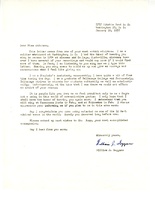 Letter, William J. Goggans to Miss Anderson, January 26, 1957 A typed letter from then soldier, educator, and musician William James Goggans (1933-2003) to globally renowned contralto Marian Anderson Fisher (1897-1993). In his letter, Goggans expresses his admiration for Marian Anderson. He congratulates her for being selected as one of the 10 most admired women in the world and asks her to inform him if she plans to perform in the Washington, D.C. area in the near future.
Letter, William J. Goggans to Miss Anderson, January 26, 1957 A typed letter from then soldier, educator, and musician William James Goggans (1933-2003) to globally renowned contralto Marian Anderson Fisher (1897-1993). In his letter, Goggans expresses his admiration for Marian Anderson. He congratulates her for being selected as one of the 10 most admired women in the world and asks her to inform him if she plans to perform in the Washington, D.C. area in the near future. -
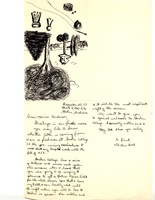 Letter, Helen Good to Marian Anderson, December 20, 1957 This letter was sent by Helen Marie Good (March 15, 1939-) of Elkhart, Indiana to Marian Anderson (February 27, 1897-April 8, 1993) on April 17th, 1951. The letter was written by Good to introduce herself to Anderson, and to express her and her mother’s excitement to see her in concert at Goshen College in the summer of 1957.
Letter, Helen Good to Marian Anderson, December 20, 1957 This letter was sent by Helen Marie Good (March 15, 1939-) of Elkhart, Indiana to Marian Anderson (February 27, 1897-April 8, 1993) on April 17th, 1951. The letter was written by Good to introduce herself to Anderson, and to express her and her mother’s excitement to see her in concert at Goshen College in the summer of 1957. -
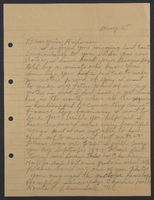 Letter, Charlie Hall Jr. to Miss Anderson, May 5, 1939 A letter from Charlie Hall Jr., a 16-year-old African American farmer and 10th-grade student from Lawndale, North Carolina, to singer Marian Anderson, dated May 5, 1939. Written shortly after Anderson’s historic Easter concert at the Lincoln Memorial, the letter conveys Hall’s admiration for her artistry and resilience, as well as parallels to his own life. Weeks earlier, Charlie had heard Anderson’s voice—maybe through the radio, maybe from news of her historic performance at the Lincoln Memorial and called it “beautiful”.
Letter, Charlie Hall Jr. to Miss Anderson, May 5, 1939 A letter from Charlie Hall Jr., a 16-year-old African American farmer and 10th-grade student from Lawndale, North Carolina, to singer Marian Anderson, dated May 5, 1939. Written shortly after Anderson’s historic Easter concert at the Lincoln Memorial, the letter conveys Hall’s admiration for her artistry and resilience, as well as parallels to his own life. Weeks earlier, Charlie had heard Anderson’s voice—maybe through the radio, maybe from news of her historic performance at the Lincoln Memorial and called it “beautiful”. -
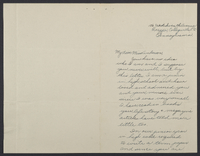 Letter, Mary Emma Jones to Miss Anderson, 1945 This letter was sent by Mary Emma Jones (1928-) of Trappe, Collegeville, Pennsylvania to Marian Anderson (February 27, 1897-April 8, 1993) in 1945, presumably towards the end of Mary’s junior year at Collegeville Trappe High School. The purpose of this letter is to request compelling information from Anderson so that her junior year term paper would be impressive, and make her parents proud (page 2). Jones repeatedly offers compliments, gratitude, and appreciation to Anderson. She notes that she has attended Anderson’s concerts in Philadelphia, which would be about an hour (roughly 32 miles) from Collegeville, PA.
Letter, Mary Emma Jones to Miss Anderson, 1945 This letter was sent by Mary Emma Jones (1928-) of Trappe, Collegeville, Pennsylvania to Marian Anderson (February 27, 1897-April 8, 1993) in 1945, presumably towards the end of Mary’s junior year at Collegeville Trappe High School. The purpose of this letter is to request compelling information from Anderson so that her junior year term paper would be impressive, and make her parents proud (page 2). Jones repeatedly offers compliments, gratitude, and appreciation to Anderson. She notes that she has attended Anderson’s concerts in Philadelphia, which would be about an hour (roughly 32 miles) from Collegeville, PA. -
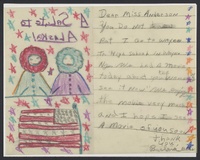 Letter, Barlana Bates to Miss Anderson This letter was sent by Barlana Bates (c. 1942) to Marian Anderson (February 27, 1897-April 8, 1993) sometime after December 30th, 1957. The letter appears to have been drawn on tracing paper. The front of the card is very colorful, with an illustration drawn with crayon of two people in parkas above an American flag, and below text that reads “A Salute to Alaska!”
Letter, Barlana Bates to Miss Anderson This letter was sent by Barlana Bates (c. 1942) to Marian Anderson (February 27, 1897-April 8, 1993) sometime after December 30th, 1957. The letter appears to have been drawn on tracing paper. The front of the card is very colorful, with an illustration drawn with crayon of two people in parkas above an American flag, and below text that reads “A Salute to Alaska!” -
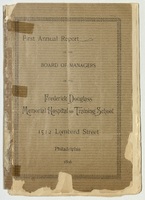 First Annual Report of the Board of Managers of the Frederick Douglass Memorial Hospital and Training School, 1512 Lombard Street Philadelphia 1896 Founded in 1895 by Dr. Nathan F. Mossell (1856 - 1946), the Frederick Douglass Memorial Hospital and Training School was the first Black owned and operated healthcare institution in the country (Barbara Bates 1992).
First Annual Report of the Board of Managers of the Frederick Douglass Memorial Hospital and Training School, 1512 Lombard Street Philadelphia 1896 Founded in 1895 by Dr. Nathan F. Mossell (1856 - 1946), the Frederick Douglass Memorial Hospital and Training School was the first Black owned and operated healthcare institution in the country (Barbara Bates 1992). -
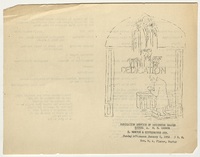 Dedication Service of Communion Drapes Bethel A.M.E. Church This ceremony documented a church dedication service at Bethel African Methodist Episcopal on January 6, 1952. Located on Rittenhouse Street in the Germantown section of Philadelphia, the program celebrated the consecration of new communion drapes. The service blended liturgy with community devotion, invoked the Trinity and called all generations to gather in unity.
Dedication Service of Communion Drapes Bethel A.M.E. Church This ceremony documented a church dedication service at Bethel African Methodist Episcopal on January 6, 1952. Located on Rittenhouse Street in the Germantown section of Philadelphia, the program celebrated the consecration of new communion drapes. The service blended liturgy with community devotion, invoked the Trinity and called all generations to gather in unity. -
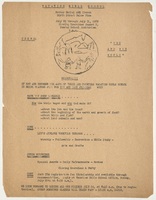 Flyer for Vacation Bible School This is a flyer for a daily Vacation Bible School held in the Sunday School Auditorium at the Mother Bethel AME Church from July 20-31st, 1959.
Flyer for Vacation Bible School This is a flyer for a daily Vacation Bible School held in the Sunday School Auditorium at the Mother Bethel AME Church from July 20-31st, 1959. -
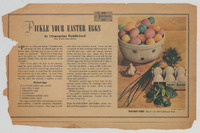 "Pickle Your Easter Eggs" The front and back of a clipping pasted in a scrapbook from the Mother Bethel African Methodist Episcopal (AME) Church. The clipping contains a recipe for pickling dyed Easter eggs written by culinary journalist Clementine Paddleford. The back contains various advertisements.
"Pickle Your Easter Eggs" The front and back of a clipping pasted in a scrapbook from the Mother Bethel African Methodist Episcopal (AME) Church. The clipping contains a recipe for pickling dyed Easter eggs written by culinary journalist Clementine Paddleford. The back contains various advertisements. -
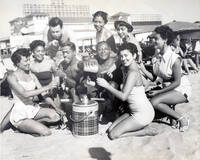 [Sammy Davis, Jr. on Chicken Bone Beach in Atlantic City, New Jersey] Entertainer Sammy Davis, Jr. having fun with friends on Chicken Bone Beach in Atlantic City, New Jersey. Sammy Davis Jr. was an actor and musician famous for being a part of the famed "Rat Pack" in the 1950s and 1960s.
[Sammy Davis, Jr. on Chicken Bone Beach in Atlantic City, New Jersey] Entertainer Sammy Davis, Jr. having fun with friends on Chicken Bone Beach in Atlantic City, New Jersey. Sammy Davis Jr. was an actor and musician famous for being a part of the famed "Rat Pack" in the 1950s and 1960s. -
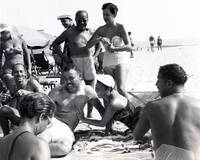 [Joe Louis on Chicken Bone Beach in Atlantic City, New Jersey] A black and white photograph taken by John W. Mosley (1907-1969). The photo features heavyweight boxing champion Joe Louis (1914-1981) who sits in the center socializing with eight people on Chicken Bone Beach in Atlantic City, New Jersey. From 1937 to 1949, Joe Louis reigned as the heavyweight boxing champion of the world. He defended his title 25 times and was beaten only three times (Martha Louis 1991).
[Joe Louis on Chicken Bone Beach in Atlantic City, New Jersey] A black and white photograph taken by John W. Mosley (1907-1969). The photo features heavyweight boxing champion Joe Louis (1914-1981) who sits in the center socializing with eight people on Chicken Bone Beach in Atlantic City, New Jersey. From 1937 to 1949, Joe Louis reigned as the heavyweight boxing champion of the world. He defended his title 25 times and was beaten only three times (Martha Louis 1991). -
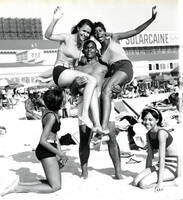 Gloria Phillis, Butch Williams, and Cheryl Steele on Chicken Bone Beach in Atlantic City, New Jersey A black and white photograph taken by John W. Mosley. The image features five young Black people at the famous Chicken Bone Beach in Atlantic City, New Jersey.
Gloria Phillis, Butch Williams, and Cheryl Steele on Chicken Bone Beach in Atlantic City, New Jersey A black and white photograph taken by John W. Mosley. The image features five young Black people at the famous Chicken Bone Beach in Atlantic City, New Jersey. -
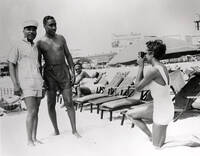 [Dr. Martin Luther King Jr. on Chicken Bone Beach] Civil rights leader Martin Luther King, Jr. and Rev. Russell A. Roberts posed for a snapshot while relaxing on segregated Chicken Bone Beach in Atlantic City, New Jersey.
[Dr. Martin Luther King Jr. on Chicken Bone Beach] Civil rights leader Martin Luther King, Jr. and Rev. Russell A. Roberts posed for a snapshot while relaxing on segregated Chicken Bone Beach in Atlantic City, New Jersey. -
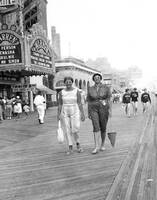 [Two women walking on the Boardwalk in Atlantic City, NJ] A black and white photograph taken by John W. Mosley. The image features two stylish Black women walking the boardwalk near Chicken Bone Beach in Atlantic City, New Jersey. The pair smile while sporting cat-eyed frame sunglasses. The Warren Theater–formerly the Warner Theater and currently The Hook–sits in the background.
[Two women walking on the Boardwalk in Atlantic City, NJ] A black and white photograph taken by John W. Mosley. The image features two stylish Black women walking the boardwalk near Chicken Bone Beach in Atlantic City, New Jersey. The pair smile while sporting cat-eyed frame sunglasses. The Warren Theater–formerly the Warner Theater and currently The Hook–sits in the background. -
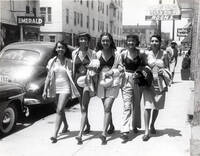 [African-American sunbathers stroll down Missouri Avenue] Five smiling and styling women take a coordinated step forward down Missouri Avenue around Chicken Bone Beach, New Jersey.
[African-American sunbathers stroll down Missouri Avenue] Five smiling and styling women take a coordinated step forward down Missouri Avenue around Chicken Bone Beach, New Jersey. -
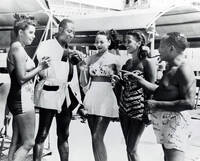 [Group of people having cocktails on the beach] Charles L. Blockson Afro-American Collection: Chicken Bone Beach was the segregated section for African Americans on Atlantic City's beach area. Between 1900 and the early 1950s, African Americans were socially restricted to use the Missouri Avenue Beach Area. Since many vacationing Black families arrived with chicken-laden hampers, the strip became affectionately named “Chicken Bone Beach”.
[Group of people having cocktails on the beach] Charles L. Blockson Afro-American Collection: Chicken Bone Beach was the segregated section for African Americans on Atlantic City's beach area. Between 1900 and the early 1950s, African Americans were socially restricted to use the Missouri Avenue Beach Area. Since many vacationing Black families arrived with chicken-laden hampers, the strip became affectionately named “Chicken Bone Beach”. -
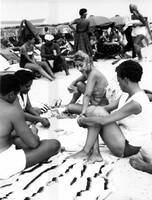 [People playing cards on the beach] A black and white photograph taken by John W. Mosley (1907-1969). The photo features four unidentified Black people playing cards at Chicken Bone Beach. In the background, beach goers socialize in beach chairs.
[People playing cards on the beach] A black and white photograph taken by John W. Mosley (1907-1969). The photo features four unidentified Black people playing cards at Chicken Bone Beach. In the background, beach goers socialize in beach chairs. -
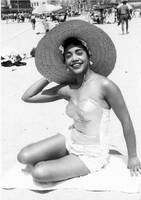 [Woman wearing large straw hat poses on the beach] This photo features a smiling, glowing woman in a one-piece strapless bathing suit and a large straw hat posing in the sand in the sunshine at Chicken Bone Beach.
[Woman wearing large straw hat poses on the beach] This photo features a smiling, glowing woman in a one-piece strapless bathing suit and a large straw hat posing in the sand in the sunshine at Chicken Bone Beach. -
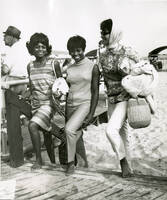 [African-American women pose carrying beach supplies in Atlantic City.] A black and white photograph taken by John W. Mosley. The image features three stylish, unidentified Black women posing on the steps of the boardwalk near Chicken Bone Beach in Atlantic City, New Jersey. Belongings in hand, two of the women smile directly towards the camera, while the other smiles while looking to the side.
[African-American women pose carrying beach supplies in Atlantic City.] A black and white photograph taken by John W. Mosley. The image features three stylish, unidentified Black women posing on the steps of the boardwalk near Chicken Bone Beach in Atlantic City, New Jersey. Belongings in hand, two of the women smile directly towards the camera, while the other smiles while looking to the side. -
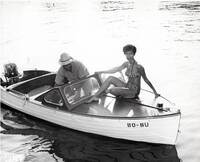 [Man and woman in a motorboat] Chicken Bone Beach was the segregated section for African Americans on Atlantic City's beach area. Between 1900 and the early 1950s, African Americans were socially restricted to use the Missouri Avenue Beach Area.
[Man and woman in a motorboat] Chicken Bone Beach was the segregated section for African Americans on Atlantic City's beach area. Between 1900 and the early 1950s, African Americans were socially restricted to use the Missouri Avenue Beach Area. -
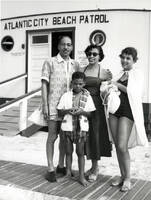 [Family at the Atlantic City Beach Patrol Station] Charles L. Blockson Afro-American Collection: Chicken Bone Beach was the segregated section for African Americans on Atlantic City's beach area. Between 1900 and the early 1950s, African Americans were socially restricted to use the Missouri Avenue Beach Area. Since many vacationing Black families arrived with chicken-laden hampers, the strip became affectionately named “Chicken Bone Beach”.
[Family at the Atlantic City Beach Patrol Station] Charles L. Blockson Afro-American Collection: Chicken Bone Beach was the segregated section for African Americans on Atlantic City's beach area. Between 1900 and the early 1950s, African Americans were socially restricted to use the Missouri Avenue Beach Area. Since many vacationing Black families arrived with chicken-laden hampers, the strip became affectionately named “Chicken Bone Beach”. -
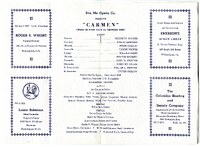 The Dra Mu Opera Company presents Carmen Program for a concert given by the Dra Mu Opera Company on November 3, 1947 at the Academy of Music.
The Dra Mu Opera Company presents Carmen Program for a concert given by the Dra Mu Opera Company on November 3, 1947 at the Academy of Music. -
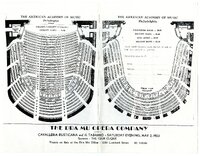 Dra Mu Opera Company Presents Cavalleria and Il Tabarro The Dra-Mu Opera Company, "Dra-Mu", was a significant Black opera company in Philadelphia, active during the mid-20th century. Co-founded by Raymond L. Smith and Henri Elkan (Van Atta 1980), the company provided a platform for Black artists to perform operatic works at a time when opportunities in mainstream opera were limited due to racial discrimination.
Dra Mu Opera Company Presents Cavalleria and Il Tabarro The Dra-Mu Opera Company, "Dra-Mu", was a significant Black opera company in Philadelphia, active during the mid-20th century. Co-founded by Raymond L. Smith and Henri Elkan (Van Atta 1980), the company provided a platform for Black artists to perform operatic works at a time when opportunities in mainstream opera were limited due to racial discrimination. -
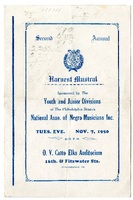 Harvest Musical Program A musical program sponsored by the Youth and Junior Divisions of The Philadelphia Branch National Association of Negro Musicians Inc.
Harvest Musical Program A musical program sponsored by the Youth and Junior Divisions of The Philadelphia Branch National Association of Negro Musicians Inc. -
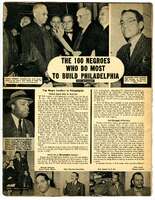 The 100 Negroes Who Do Most To Build Philadelphia Color Magazine, February 1950. Ira James Kohath Wells (1898–1997), founder of Color magazine, was born in Tamo, Arkansas. He earned a business degree from Lincoln University in 1923, where he co-founded the Colored Student Movement and joined the Student Anti-Lynching delegation to President Warren Harding.
The 100 Negroes Who Do Most To Build Philadelphia Color Magazine, February 1950. Ira James Kohath Wells (1898–1997), founder of Color magazine, was born in Tamo, Arkansas. He earned a business degree from Lincoln University in 1923, where he co-founded the Colored Student Movement and joined the Student Anti-Lynching delegation to President Warren Harding. -
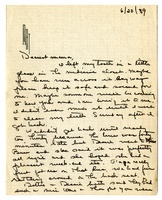 Letter to Mama, From Mary Mary, the letter writer, tells her mother she accidentally left a tooth in a glass in the medicine cabinet and asks her to keep it safe until someone can bring it to them. She describes returning late from a weekend visit due to a bus delay, noting that friends Dottie and Deasie enjoyed the trip.
Letter to Mama, From Mary Mary, the letter writer, tells her mother she accidentally left a tooth in a glass in the medicine cabinet and asks her to keep it safe until someone can bring it to them. She describes returning late from a weekend visit due to a bus delay, noting that friends Dottie and Deasie enjoyed the trip. -
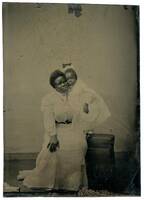 "Nancy Greene, Emma Greene, 1904" This photograph is a tintype of Nancy Kate Greene (1875-1926) and her daughter Emma Epps (née Greene) (1902-February 27, 1989), likely taken in Princeton, New Jersey. Invented in the 1850s and produced into the 1900s, tintypes were photographs on thin iron metal that were often hand-colored and mostly used for portraits (Library of Congress, n.d.).
"Nancy Greene, Emma Greene, 1904" This photograph is a tintype of Nancy Kate Greene (1875-1926) and her daughter Emma Epps (née Greene) (1902-February 27, 1989), likely taken in Princeton, New Jersey. Invented in the 1850s and produced into the 1900s, tintypes were photographs on thin iron metal that were often hand-colored and mostly used for portraits (Library of Congress, n.d.). -
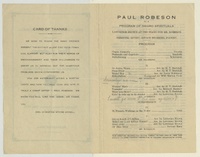 Mrs. Christine Moore Howell presents Paul Robeson in a Program of Negro Spirituals for the Benefit of the Witherspoon Y.M.C.A. 1932 January 28. The January 1932 Paul Robeson concert program was hosted by the Witherspoon Y.M.C.A. It was Princeton’s all-Black YMCA branch that served as a social, recreational, educational, and civic hub for nearby Black neighborhoods through the 1930s. It occupied the building at (now) 102 Witherspoon Street (earlier locations at Jackson & Green/Witherspoon) and employed local Black leaders as directors by the 1920s, and is documented in Princeton archives and local histories (Hsp-Admin 2017). 
Mrs. Christine Moore Howell presents Paul Robeson in a Program of Negro Spirituals for the Benefit of the Witherspoon Y.M.C.A. 1932 January 28. The January 1932 Paul Robeson concert program was hosted by the Witherspoon Y.M.C.A. It was Princeton’s all-Black YMCA branch that served as a social, recreational, educational, and civic hub for nearby Black neighborhoods through the 1930s. It occupied the building at (now) 102 Witherspoon Street (earlier locations at Jackson & Green/Witherspoon) and employed local Black leaders as directors by the 1920s, and is documented in Princeton archives and local histories (Hsp-Admin 2017).  -
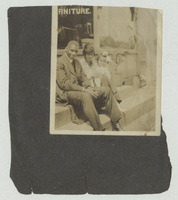 Paul Robeson with Christine Moore Howell and a child. Paul Robeson with Christine Moore Howell and a child, in front of William Moore’s furniture store on Spring Street.
Paul Robeson with Christine Moore Howell and a child. Paul Robeson with Christine Moore Howell and a child, in front of William Moore’s furniture store on Spring Street. -
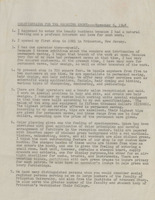 Questionnaire for the Magazine Ebony This questionnaire entitled “QUESTIONNAIRE FOR THE MAGAZINE EBONY----November 6, 1948” is five pages long with responses to 38 questions. The responses are by Christine Moore Howell (March 19, 1898-December 13, 1972) of Princeton, New Jersey.
Questionnaire for the Magazine Ebony This questionnaire entitled “QUESTIONNAIRE FOR THE MAGAZINE EBONY----November 6, 1948” is five pages long with responses to 38 questions. The responses are by Christine Moore Howell (March 19, 1898-December 13, 1972) of Princeton, New Jersey. -
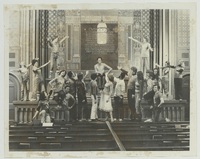 Photograph of the cast and crew of David's Rock Likely taken during a pre-production rehearsal at a nearby church, as suggested by the rows of pews and hymnals in the foreground.
Photograph of the cast and crew of David's Rock Likely taken during a pre-production rehearsal at a nearby church, as suggested by the rows of pews and hymnals in the foreground. -
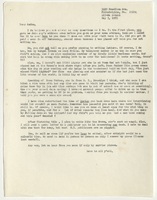 Letter from Anita Cornwell to Audre Lorde An impassioned letter between women who had a deep friendship. Audre Lorde (1934 - 1992) was an American poet, novelist, memoirist, essayist (IMDb, n.d.). She received a master’s degree in Library Science and worked as a young adult librarian and school librarian in the 1960’s (Cerro Cosco Community College 2025). She also published poetry influenced by her reactions to racism, sexism, and homophobia. She married and had two children. Her first major book of poetry, Coal was published in 1976, and she continued to publish until her death from liver cancer in 1992.
Letter from Anita Cornwell to Audre Lorde An impassioned letter between women who had a deep friendship. Audre Lorde (1934 - 1992) was an American poet, novelist, memoirist, essayist (IMDb, n.d.). She received a master’s degree in Library Science and worked as a young adult librarian and school librarian in the 1960’s (Cerro Cosco Community College 2025). She also published poetry influenced by her reactions to racism, sexism, and homophobia. She married and had two children. Her first major book of poetry, Coal was published in 1976, and she continued to publish until her death from liver cancer in 1992. -
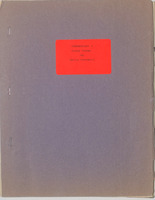 Chronicles I, Prose Poems by Anita Cromwell Anita Cornwell (1923 - 2023). Ms Cornwell’s “Chronicles 1, Prose Poems in 1986” is captured in digital form. The document opens with a dedication to Cornwell’s mother and a short biography highlighting her career as a writer and playwright, followed by the table of contents that lists five poems. They are: 1. First Love and Other Traumas 2. Second Coming 3. Sordid Mansions 4. In Praise of the Foremothers 5. Remembrance of Sister-Love
Chronicles I, Prose Poems by Anita Cromwell Anita Cornwell (1923 - 2023). Ms Cornwell’s “Chronicles 1, Prose Poems in 1986” is captured in digital form. The document opens with a dedication to Cornwell’s mother and a short biography highlighting her career as a writer and playwright, followed by the table of contents that lists five poems. They are: 1. First Love and Other Traumas 2. Second Coming 3. Sordid Mansions 4. In Praise of the Foremothers 5. Remembrance of Sister-Love -
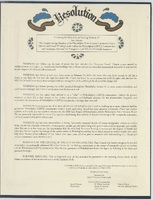 Council of the City of Philadelphia, Resolution Honoring the Rich Life and Loving Memory of Jaci Adams **Honoring Jaci Adams: A Legacy of Advocacy and Leadership** Jaci Adams (1956 - 2014) was a remarkable transwoman whose life embodied resilience and the "American Dream." Born in Beckley, WV., and raised in North Philadelphia, Adams overcame a history of abuse, addiction, and incarceration to become a fierce advocate for social justice, particularly for the trans community (Staff 2014).
Council of the City of Philadelphia, Resolution Honoring the Rich Life and Loving Memory of Jaci Adams **Honoring Jaci Adams: A Legacy of Advocacy and Leadership** Jaci Adams (1956 - 2014) was a remarkable transwoman whose life embodied resilience and the "American Dream." Born in Beckley, WV., and raised in North Philadelphia, Adams overcame a history of abuse, addiction, and incarceration to become a fierce advocate for social justice, particularly for the trans community (Staff 2014). -
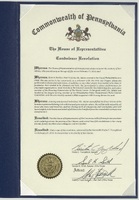 Commonwealth of Pennsylvania, The House of Representatives, Condolence Resolution Condolence resolution in honor of Jaci Adams (1956 - 2014). The law enforcement officer was a remarkable transwoman whose life embodied resilience and the "American Dream." Born in Beckley, WV., and raised in North Philadelphia, Adams overcame a history of abuse, addiction, and incarceration to become a fierce advocate for social justice, particularly for the trans community (Staff 2014).
Commonwealth of Pennsylvania, The House of Representatives, Condolence Resolution Condolence resolution in honor of Jaci Adams (1956 - 2014). The law enforcement officer was a remarkable transwoman whose life embodied resilience and the "American Dream." Born in Beckley, WV., and raised in North Philadelphia, Adams overcame a history of abuse, addiction, and incarceration to become a fierce advocate for social justice, particularly for the trans community (Staff 2014). -
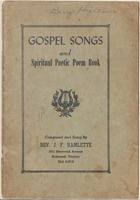 Gospel Songs and Spiritual Poetic Poem Book The book “Gospel Songs and Spiritual Poetic Poem Book” by Rev. J. F. Hamlette has four parts and is 56 pages. It has handwritten inscriptions of Ada and George Hightower's names on cover and inside, who were members of the First Colored Church in Hopewell, NJ and were among the first African Americans to live on Columbia Avenue in Hopewell.
Gospel Songs and Spiritual Poetic Poem Book The book “Gospel Songs and Spiritual Poetic Poem Book” by Rev. J. F. Hamlette has four parts and is 56 pages. It has handwritten inscriptions of Ada and George Hightower's names on cover and inside, who were members of the First Colored Church in Hopewell, NJ and were among the first African Americans to live on Columbia Avenue in Hopewell. -
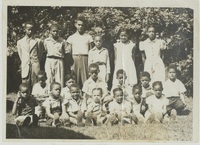 Bethel African Methodist Episcopal Church Sunday School The Bethel AME Church in Pennington was built in 1816 by a small group of free African Americans who purchased the land as an empty lot, as well as nearby lots for homes (Katmann 2014, 6). This photograph of the church’s Sunday School features nineteen children, some siblings. Patricia (née True) Payne has identified all of the children in the picture. (See reverse)
Bethel African Methodist Episcopal Church Sunday School The Bethel AME Church in Pennington was built in 1816 by a small group of free African Americans who purchased the land as an empty lot, as well as nearby lots for homes (Katmann 2014, 6). This photograph of the church’s Sunday School features nineteen children, some siblings. Patricia (née True) Payne has identified all of the children in the picture. (See reverse) -
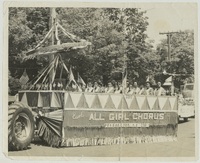 Earl's All Girl Chorus Earl's All-Girl Chorus was a Pennington singing group directed by Earl Hubbard. Earl Hubbard’s All‑Girl Chorus was a community-based chorus directed by William Earl Hubbard. For a major local pageant celebration, the Chorus performed “1865 Episode VIII” representing the year 1865—supported by an accompanist and wardrobe stylist, and composed of Black women from the area (Pennington Sesquibicentennial 250th Booklet (1958): 1865 - Episode VIII, Earl Hubbard’s Chorus 2025).
Earl's All Girl Chorus Earl's All-Girl Chorus was a Pennington singing group directed by Earl Hubbard. Earl Hubbard’s All‑Girl Chorus was a community-based chorus directed by William Earl Hubbard. For a major local pageant celebration, the Chorus performed “1865 Episode VIII” representing the year 1865—supported by an accompanist and wardrobe stylist, and composed of Black women from the area (Pennington Sesquibicentennial 250th Booklet (1958): 1865 - Episode VIII, Earl Hubbard’s Chorus 2025). -
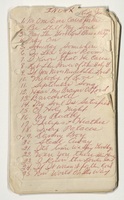 Song Lyrics, Handwritten Written by Jean Smith, a member of Earl's All-Girl Chorus, a Pennington singing group directed by Earl Hubbard. These lyric pages show the repertoire for the chorus and include both religious and gospel songs. 94 sheets of loose paper with handwritten song lyrics, mid-20th century.
Song Lyrics, Handwritten Written by Jean Smith, a member of Earl's All-Girl Chorus, a Pennington singing group directed by Earl Hubbard. These lyric pages show the repertoire for the chorus and include both religious and gospel songs. 94 sheets of loose paper with handwritten song lyrics, mid-20th century. -
 Handwritten Stoutsburg Cemetery Ledger This handwritten ledger was kept by Herbert Albert Hubbard (June 7, 1875-July 11, 1948), Beverly Mills's (co-founder of the Stoutsburg Sourland African American Museum) great-grandfather, at the Stoutsburg Cemetery. It includes minutes from Stoutsburg Cemetery Association meetings, including hymns sung and fundraising efforts, from 1912 through the 1920s.
Handwritten Stoutsburg Cemetery Ledger This handwritten ledger was kept by Herbert Albert Hubbard (June 7, 1875-July 11, 1948), Beverly Mills's (co-founder of the Stoutsburg Sourland African American Museum) great-grandfather, at the Stoutsburg Cemetery. It includes minutes from Stoutsburg Cemetery Association meetings, including hymns sung and fundraising efforts, from 1912 through the 1920s. -
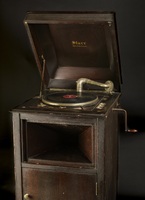 Standing Victrola Originally belonged to the Smith brothers (Alfonso, Clarence, Raymond, and Leon), who were born in Neshanic Station to Joseph Smith Jr. and Cora Smith of Pennington. The brothers pooled their money to purchase the Victrola for their family's enjoyment.
Standing Victrola Originally belonged to the Smith brothers (Alfonso, Clarence, Raymond, and Leon), who were born in Neshanic Station to Joseph Smith Jr. and Cora Smith of Pennington. The brothers pooled their money to purchase the Victrola for their family's enjoyment. -
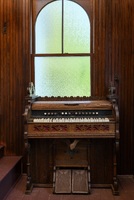 Organ Pump organ, pre-1917. Made by the Cornish Company in Washington, NJ, which ended organ production in 1917. Organ was played at the First Baptist Church in Pennington and was similar to the one that provided music at Skillman Camp Meetings from the 1890s - 1930s.
Organ Pump organ, pre-1917. Made by the Cornish Company in Washington, NJ, which ended organ production in 1917. Organ was played at the First Baptist Church in Pennington and was similar to the one that provided music at Skillman Camp Meetings from the 1890s - 1930s. -
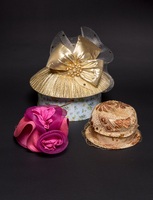 Group of 1930's - 1940's Church Hats Church hats that would have been worn by the ladies of Mt. Zion AME Church in the late 20th century.
Group of 1930's - 1940's Church Hats Church hats that would have been worn by the ladies of Mt. Zion AME Church in the late 20th century. -
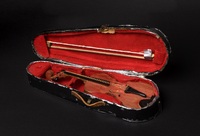 Toy Violin and Case Handmade child's violin and instrument case, late-20th century. Built by Earl Hubbard, a self-taught violinist and music teacher from the Sourlands' Black community, for his niece Danielle Thompson.
Toy Violin and Case Handmade child's violin and instrument case, late-20th century. Built by Earl Hubbard, a self-taught violinist and music teacher from the Sourlands' Black community, for his niece Danielle Thompson. -
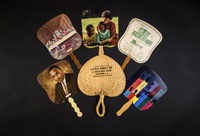 Paper and rattan church hand fans, 6 fans, 11 sides (Front View) Paper and rattan hand fans, mid-20th century. Fans have religious imagery on the front and advertisements for funeral home services on the reverse. Church fans used at Mt. Zion AME Church.
Paper and rattan church hand fans, 6 fans, 11 sides (Front View) Paper and rattan hand fans, mid-20th century. Fans have religious imagery on the front and advertisements for funeral home services on the reverse. Church fans used at Mt. Zion AME Church. -
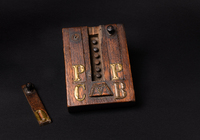 Billy Truehart milkbox "Billy Truehart's milk box," early 20th century. Handmade wooden box with metal letters on three sliding lids and nail heads within each compartment. Made by William "Billy" Truehart, grandson of Friday Truehart, while working as a handyman for the Blackwell family in Trenton, NJ.
Billy Truehart milkbox "Billy Truehart's milk box," early 20th century. Handmade wooden box with metal letters on three sliding lids and nail heads within each compartment. Made by William "Billy" Truehart, grandson of Friday Truehart, while working as a handyman for the Blackwell family in Trenton, NJ. -
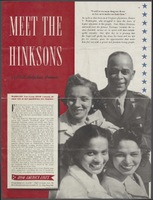 “Meet the Hinksons.” “Meet the Hinksons of Philadelphia, Penna.” is a six-page magazine article published in the Ladies’ Home Journal series “How America Lives” in August 1942. The article highlights the everyday life of the Hinkson family, including education, careers, fashion, travel, and home, and the impact of various wars on their lives.
“Meet the Hinksons.” “Meet the Hinksons of Philadelphia, Penna.” is a six-page magazine article published in the Ladies’ Home Journal series “How America Lives” in August 1942. The article highlights the everyday life of the Hinkson family, including education, careers, fashion, travel, and home, and the impact of various wars on their lives. -
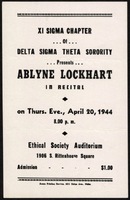 Program for recital at Ethical Society Auditorium. Lockhart's program for recital at Ethical Society Auditorium
Program for recital at Ethical Society Auditorium. Lockhart's program for recital at Ethical Society Auditorium -
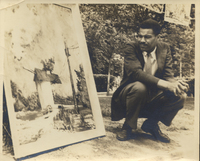 Photograph. Paul B. Moses with his painting Ice House Paul B. Moses (1929 - 1966) was born in Ardmore, Pennsylvania, attended Lower Merion High School and became one of the first Black undergraduates at Haverford College. Despite facing racism and isolation, he excelled in languages and art, studying abroad in France with the support of Albert C. Barnes, MD. After serving in the U.S. Army, he taught at institutions including the Barnes Foundation, Lincoln University, and at the American Overseas School in Rome before earning a Masters and pursuing a doctorate in art history at Harvard, where his dissertation specialized in Degas’s etchings (Moses and Scharff 2023).
Photograph. Paul B. Moses with his painting Ice House Paul B. Moses (1929 - 1966) was born in Ardmore, Pennsylvania, attended Lower Merion High School and became one of the first Black undergraduates at Haverford College. Despite facing racism and isolation, he excelled in languages and art, studying abroad in France with the support of Albert C. Barnes, MD. After serving in the U.S. Army, he taught at institutions including the Barnes Foundation, Lincoln University, and at the American Overseas School in Rome before earning a Masters and pursuing a doctorate in art history at Harvard, where his dissertation specialized in Degas’s etchings (Moses and Scharff 2023). -
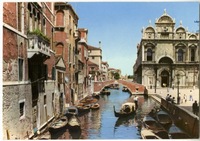 Postcard. Paul B. Moses to Violette de Mazia About 1950, Paul Moses wrote to Violette de Mazia from Europe, joking he once paid for lodging in Venice with a 33⅓ record. Traveling with Philadelphia friends through Capri, Florence, and Venice, he calls Capri the most beautiful place he has seen and looks forward to studying the French Primitives in France with renewed excitement.
Postcard. Paul B. Moses to Violette de Mazia About 1950, Paul Moses wrote to Violette de Mazia from Europe, joking he once paid for lodging in Venice with a 33⅓ record. Traveling with Philadelphia friends through Capri, Florence, and Venice, he calls Capri the most beautiful place he has seen and looks forward to studying the French Primitives in France with renewed excitement. -
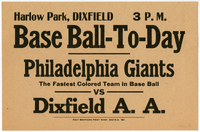 Base-ball-to-day Philadelphia Giants the fastest colored team in base ball vs Dixfield A.A. The Handbill for Philadelphia Giants game, playing at Harlow Park, Dixfield at 3 P.M. Formed in 1902, the Philadelphia Giants was a powerhouse independent Black team until disbanding in 1911, forced by player defections (Wikipedia contributors 2025).
Base-ball-to-day Philadelphia Giants the fastest colored team in base ball vs Dixfield A.A. The Handbill for Philadelphia Giants game, playing at Harlow Park, Dixfield at 3 P.M. Formed in 1902, the Philadelphia Giants was a powerhouse independent Black team until disbanding in 1911, forced by player defections (Wikipedia contributors 2025). -
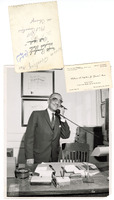 William Upshur on phone at desk A black and white photograph taken by John W. Mosley (1907-1969) featuring William “Bill” Arthur Upshur Jr. (1894-1963) on the phone at his office desk. His business card for his funeral home is stapled to the photo. Another photo flipped right side down sits above. It has handwritten inscriptions.
William Upshur on phone at desk A black and white photograph taken by John W. Mosley (1907-1969) featuring William “Bill” Arthur Upshur Jr. (1894-1963) on the phone at his office desk. His business card for his funeral home is stapled to the photo. Another photo flipped right side down sits above. It has handwritten inscriptions. -
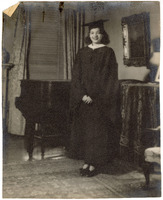 Georgine E. Upshur [Willis], 1943 University of Pennsylvania Graduation This photograph features Mrs. Georgine "Gene" Elizabeth (née Upshur) Willis posing for her graduation from the University of Pennsylvania in 1943.
Georgine E. Upshur [Willis], 1943 University of Pennsylvania Graduation This photograph features Mrs. Georgine "Gene" Elizabeth (née Upshur) Willis posing for her graduation from the University of Pennsylvania in 1943. -
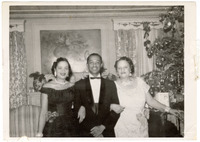 Georgine Upshur Willis, William Willis, and Agnes Saunders Chew Upshur in formal attire during Christmas holiday A black and white photograph featuring Georgine Upshur Willis, her husband William Willis, and her mother Agnes Saunders Chew Upshur in formal attire during the Christmas holiday. More information is available in the annotation of the document.
Georgine Upshur Willis, William Willis, and Agnes Saunders Chew Upshur in formal attire during Christmas holiday A black and white photograph featuring Georgine Upshur Willis, her husband William Willis, and her mother Agnes Saunders Chew Upshur in formal attire during the Christmas holiday. More information is available in the annotation of the document. -
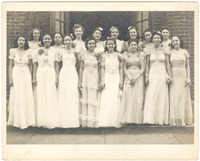 Gene's [Georgine E. Upshur [Willis]] Coming Out Party This photograph features Georgine “Gene” Elizabeth Upshur Willis and 15 other graduates of Philadelphia High School for Girls in June 1939. They are smiling and dressed up.
Gene's [Georgine E. Upshur [Willis]] Coming Out Party This photograph features Georgine “Gene” Elizabeth Upshur Willis and 15 other graduates of Philadelphia High School for Girls in June 1939. They are smiling and dressed up. -
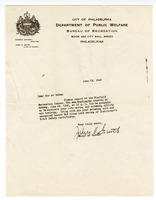 Letter addressed to “Sir or Madam” from City of Philadelphia Department of Public Welfare, Bureau of Recreation about reporting to Funfield Recreation Center “to demonstrate your life saving and swimming ability and training,” June 18, 1942 Department of Public Welfare, Bureau of Recreation letter about swim certification; a 1942 letter from the City of Philadelphia Department of Public Welfare, Bureau of Recreation about swimming training
Letter addressed to “Sir or Madam” from City of Philadelphia Department of Public Welfare, Bureau of Recreation about reporting to Funfield Recreation Center “to demonstrate your life saving and swimming ability and training,” June 18, 1942 Department of Public Welfare, Bureau of Recreation letter about swim certification; a 1942 letter from the City of Philadelphia Department of Public Welfare, Bureau of Recreation about swimming training -
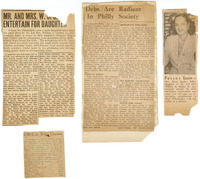 Mrs. Gene Upshur Willis news clippings This collection of news clippings are about Upshur family achievements, including: Georgine Upshur and a Y.W.C.A. baby contest, her Philadelphia High School for Girls graduation and coming out parties, and passing of the state mortician’s exam circa 1949.
Mrs. Gene Upshur Willis news clippings This collection of news clippings are about Upshur family achievements, including: Georgine Upshur and a Y.W.C.A. baby contest, her Philadelphia High School for Girls graduation and coming out parties, and passing of the state mortician’s exam circa 1949. -
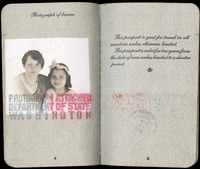 Passport photograph of Agnes Upshur and Georgine Upshur An insert from Agnes C. Upshur’s day journal “My Trip Abroad.” The insert features her passport with a passport photograph of her and her young daughter Georgine Elizabeth Upshur. More information is available in the annotation of the document.
Passport photograph of Agnes Upshur and Georgine Upshur An insert from Agnes C. Upshur’s day journal “My Trip Abroad.” The insert features her passport with a passport photograph of her and her young daughter Georgine Elizabeth Upshur. More information is available in the annotation of the document. -
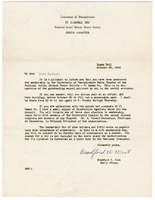 Letter to Georgine Upshur informing her of her nomination for membership in the University of Pennsylvania Delta Chapter of the National Social Science Honor Society – Pi Gamma Mu, October 23, 1942 This letter was sent to Miss Georgine “Gene” Elizabeth Upshur on October 23, 1942 from Pi Gamma Mu, the National Social Science Honor Society’s Delta Chapter at the University of Pennsylvania notifying her of her nomination for membership.
Letter to Georgine Upshur informing her of her nomination for membership in the University of Pennsylvania Delta Chapter of the National Social Science Honor Society – Pi Gamma Mu, October 23, 1942 This letter was sent to Miss Georgine “Gene” Elizabeth Upshur on October 23, 1942 from Pi Gamma Mu, the National Social Science Honor Society’s Delta Chapter at the University of Pennsylvania notifying her of her nomination for membership. -
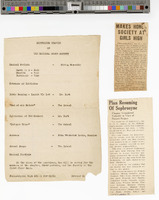 National Honor Society news clippings A 1938 news clipping about Georgine E. Upshur being elected to the honor society and nomination as the second colored girl in history
National Honor Society news clippings A 1938 news clipping about Georgine E. Upshur being elected to the honor society and nomination as the second colored girl in history -
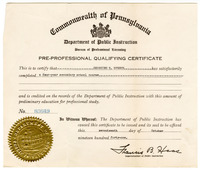 Commonwealth of Pennsylvania Department of Public Instruction Bureau of Professional Licensing Pre-Professional Qualifying Certificate This certificate from the Commonwealth of Pennsylvania Department of Public Instruction’s Bureau of Professional Licensing Pre-Professional Qualifying Certificate was granted to Georgine E. Upshur for completion of a four-year secondary school course in 1941. This was a modified certificate given to Black educators.
Commonwealth of Pennsylvania Department of Public Instruction Bureau of Professional Licensing Pre-Professional Qualifying Certificate This certificate from the Commonwealth of Pennsylvania Department of Public Instruction’s Bureau of Professional Licensing Pre-Professional Qualifying Certificate was granted to Georgine E. Upshur for completion of a four-year secondary school course in 1941. This was a modified certificate given to Black educators. -
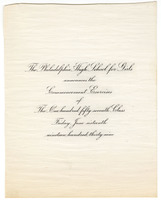 The Philadelphia High School for Girls commencement announcement The 157th Graduating Class: June 16, 1939. The Girls Normal School, aka, Philadelphia High School for Girls was established in 1848 as the first publicly supported high school for girls in Pennsylvania (Wikipedia contributors, n.d.).
The Philadelphia High School for Girls commencement announcement The 157th Graduating Class: June 16, 1939. The Girls Normal School, aka, Philadelphia High School for Girls was established in 1848 as the first publicly supported high school for girls in Pennsylvania (Wikipedia contributors, n.d.). -
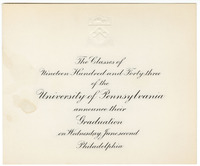 Invitation to the graduation of the University of Pennsylvania classes of 1943 This invitation card is part of a collection that also includes “Diary of the Women of the Class of 1943, University of Pennsylvania, The 1943 Almanack” containing inserts of correspondence, documents, and programs related to Georgine E. Upshur’s college education at University of Pennsylvania (Georgine E. Upshur Willis Collection n.d.).
Invitation to the graduation of the University of Pennsylvania classes of 1943 This invitation card is part of a collection that also includes “Diary of the Women of the Class of 1943, University of Pennsylvania, The 1943 Almanack” containing inserts of correspondence, documents, and programs related to Georgine E. Upshur’s college education at University of Pennsylvania (Georgine E. Upshur Willis Collection n.d.).
